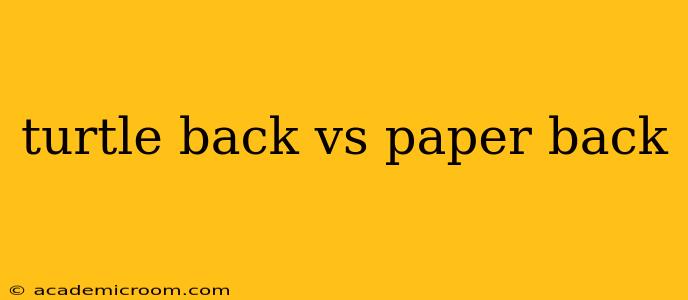Choosing the right binding for your book is a crucial decision, impacting its durability, cost, and overall aesthetic appeal. Two popular options frequently compared are turtleback binding and paperback binding. While both are relatively affordable, they differ significantly in their construction and resulting longevity. This comprehensive guide will delve into the specifics of each, highlighting their advantages and disadvantages to help you make an informed decision.
What is Turtleback Binding?
Turtleback binding, also known as case binding, is a robust method that uses a durable cover board adhered to the text block. The spine is then reinforced with cloth or paper, resulting in a book with a strong, flexible spine. Imagine a turtle's shell – that's the essence of the name; the cover protects the pages like a shell. This binding method offers a professional finish and is ideal for books that require frequent handling or repeated opening and closing, such as textbooks, cookbooks, or journals.
Advantages of Turtleback Binding:
- Durability: Turtleback binding significantly outlasts paperback binding, making it perfect for books intended for long-term use. The reinforced spine prevents cracking and tearing.
- Professional Appearance: The binding creates a clean, finished look, enhancing the overall presentation of the book.
- Lay-Flat Capability: Depending on the thickness and construction, turtleback books can often lie relatively flat when open, improving readability.
Disadvantages of Turtleback Binding:
- Cost: Turtleback binding is generally more expensive than paperback binding due to the additional materials and labor involved.
- Production Time: The process is more time-consuming, potentially leading to longer production lead times.
- Less Flexible Design Options: While customization is possible, the design options are often less flexible compared to paperback binding.
What is Paperback Binding?
Paperback binding, also referred to as saddle stitch or perfect binding, is a simpler and more cost-effective method. For saddle stitch, pages are folded in half and stapled along the spine. Perfect binding involves gluing the edges of the pages together and then attaching a cover. This method is commonly used for magazines, short books, and low-page-count publications.
Advantages of Paperback Binding:
- Cost-Effectiveness: Paperback binding is significantly cheaper than turtleback binding, making it ideal for budget-conscious projects or high-volume printing.
- Faster Production: The simpler process leads to quicker turnaround times.
- Design Flexibility: Paperback binding offers greater flexibility in terms of cover design and materials.
Disadvantages of Paperback Binding:
- Lower Durability: Paperback bindings are prone to wear and tear, especially with frequent use. The spine can easily crack or the pages can fall out.
- Less Professional Appearance: While modern paperback designs can look very polished, the binding generally doesn't offer the same level of professional finish as turtleback.
- Limited Lay-Flat Capability: Paperback books, particularly those with perfect binding, tend not to lay flat when open.
Which Binding Method is Right for You?
The optimal choice between turtleback and paperback binding depends heavily on your specific needs and priorities.
-
Choose Turtleback binding if: Durability, a professional appearance, and lay-flat capability are essential. You're willing to pay a premium for a longer-lasting, high-quality book.
-
Choose Paperback binding if: Cost and speed are paramount. The book's lifespan is less critical, and design flexibility is a priority.
What are the different types of paperback binding?
This question addresses the nuances within paperback binding itself. There are primarily two types:
-
Saddle Stitch Binding: This is the simplest form, suitable for booklets or magazines with a low page count (typically under 64 pages). Pages are folded and stapled along the spine. It's inexpensive but less durable.
-
Perfect Binding: This method glues the edges of the pages together to create a block, which is then attached to the cover. It's suitable for books with higher page counts and offers a slightly more professional look than saddle stitch but is still less durable than turtleback.
How do I choose the right paper for my book?
While not directly related to the binding method, paper choice significantly impacts the final product's feel and quality. The type of paper will depend on factors like your budget, the desired aesthetic, and the book's intended use. Consider factors like paper weight, texture, and brightness when making your selection.
What is the cost difference between turtleback and paperback binding?
The price difference varies based on the project's scale, materials used, and printer. However, expect turtleback binding to be significantly more expensive than paperback binding, often double or more.
By carefully considering the factors outlined above, you can confidently choose the binding method that perfectly complements your book's content, intended audience, and budget. Remember to consult with a professional printer for specific guidance on your project.
